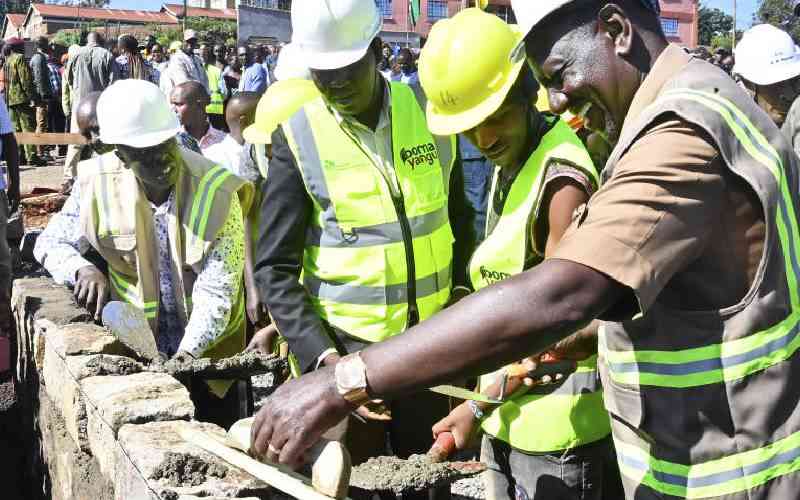The admission by Health Cabinet Secretary that more difficult days await Kenyans is a clear testament that the coronavirus monster will have a substantial edge over our health systems. We have known all along that the novel coronavirus will devastate weak health systems but even so, the advanced and fairly robust and well-resourced European health systems have suffered a great deal. Epidemiologists are concerned because of the rapid rate of infections. In the US, the infections have risen 10 fold in a 7-day period. The rate of infection in UK is doubling every three days. In Kenya, our official infection rate is still low, because we haven’t started doing targeted mass-testing yet.
The European health systems have been overwhelmed already. The mortality rate due to Covid-19 in Italy was devastating as it lost over 2,500 people in four weeks, with over 32,000 confirmed cases, their systems were struggling. Not enough beds, equipment and with an increased number of health workers quarantined because of the infection, one of the best public health system in the western world could not do anything to prevent the devastation.
The NHS is a well-funded British National Health Service. It is taxpayer-funded and offers free healthcare services to UK residents. The NHS plans to spend 123 billion pounds this year, roughly 2,200 pounds per person. The NHS has built a 4,000-bed Nightingale Hospital for Covid-19 patients needing intensive care treatment. The hospital was built with help from 200 soldiers alongside NHS staff and contractors. The NHS plans to build other Nightingale hospitals with the rising need. The NHS needs a total of 30,000 ventilators at the height of the coronavirus crisis, so far there is a total of 8,000 ventilators and 8,000 more to be delivered. A total of 41,000 ventilators will be at the disposal of the NHS with all the orders filled. The UK government procurement strategy is to encourage new local technology, scaling up production and importation. The British preparedness cannot be understated and the impact of Covid-19 can only be scaled up after the crisis has abated.
The NHIF is the main health insurer in Kenya. It covers around 25 per cent of the population, most of whom are in formal employment. Private insurers take up a very minute percent of medical insurance. Public health centres provide free services and treat other cases like malaria free of charge. Kenya has five referral facilities and the total number of doctors in 2018 was 7,333. A ratio of 1 medical doctor per 6,545 people. There are about 20,000 nurses well below the recommended WHO ratio of 1 nurse to 400. It is no longer a concern about the personnel shortage because the issue has been raised and largely ignored. According to Kenya Healthcare Federation and the Critical Care Society, Kenya has 518 ICU beds with up to 87 per cent currently occupied. There are 259 functional ventilators of which 150 are in use. This only shows the consequences of the perennial under-investment in healthcare. It also means that the country pays dearly for the obvious errors in priority setting and a clear lack of leadership in social services and welfare of the citizens.
What can we expect? What can be done? What can we learn from this? The answer cannot be simple. It has taken a pandemic to expose a weak healthcare system. Can anything be done during this difficult time? There are no choices to be made, what is left is acting, confronting our fears and being bold and practical. We should expect a stressful period of loss, economically and loss of lives. The government must cushion livelihoods who will lose their economic mainstays through loss of wages by death or loss of jobs.
The medical facilities and healthcare workers who may be affected by getting infected with Covid-19 must be compensated. This only calls for a substantial investment in the war against Covid-19. The lessons to learn from the Covid-19 pandemic are plenty. The main lesson is to re-look at the structure of our health institutions namely Kemri, NHIF and the training and human resource aspect of health workers. The doctor-to-patient ratio, nurse-to-patient ratio is appalling. Health is a sacred investment for which the returns are enormous.
Dr Bob Chweya. @ChweyaBob, [email protected]
 The Standard Group Plc is a
multi-media organization with investments in media platforms spanning newspaper
print operations, television, radio broadcasting, digital and online services. The
Standard Group is recognized as a leading multi-media house in Kenya with a key
influence in matters of national and international interest.
The Standard Group Plc is a
multi-media organization with investments in media platforms spanning newspaper
print operations, television, radio broadcasting, digital and online services. The
Standard Group is recognized as a leading multi-media house in Kenya with a key
influence in matters of national and international interest.
 The Standard Group Plc is a
multi-media organization with investments in media platforms spanning newspaper
print operations, television, radio broadcasting, digital and online services. The
Standard Group is recognized as a leading multi-media house in Kenya with a key
influence in matters of national and international interest.
The Standard Group Plc is a
multi-media organization with investments in media platforms spanning newspaper
print operations, television, radio broadcasting, digital and online services. The
Standard Group is recognized as a leading multi-media house in Kenya with a key
influence in matters of national and international interest.





